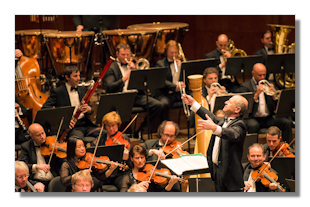
The Internet's Premier Classical Music Source
Related Links
- Latest Reviews
- More Reviews
-
By Composer
-
Collections
DVD & Blu-ray
Books
Concert Reviews
Articles/Interviews
Software
Audio
Search Amazon
Recommended Links
Site News
 Concert Review
Concert Review
Budapest Brahms in Bruges

Johannes Brahms
- Symphony #1 in C minor, Op. 68
- Symphony #2 in D Major, Op. 73
- Symphony #3 in F Major, Op. 90
- Symphony #4 in E minor, Op. 98
Budapest Festival Orchestra/Iván Fischer
Bruges, Concertgebouw, 21-22 May 2015
It doesn't happen very often you that can hear the complete Brahms symphonies cycle almost in one breath. The magnificent Budapest Festival Orchestra under Iván Fischer took up residence in the Bruges Concertgebouw again and offered all four symphonies in order of creation in two consecutive days. At the end of the run you leave the concert hall dazzled, slightly tipsy by the richness and density of Brahms' music, but also strengthened in your conviction that this symphonic corpus is indeed an inexhaustible monument.
Yet the Brahms symphonies are also a particular tough nut to crack and the trouble with these cycles in concert (or for that matter on disc) is that not many conductors manage to be equally convincing in all four of them. Recently, Riccardo Chailly and the Leipzig Gewandhaus Orchestra came really close, but with Fischer it seems to be another matter. To his credit, he too wants to shed new light on these symphonies that have been performed, recorded and reinterpreted hundreds of times. Fischer favors warmth, elegance and opulence, pulling Brahms away from any classical rigor or astringency. There is a pervading feel of coziness and even at times complacency. It works to some extent, not in the least because Fischer can capitalize on an orchestra that is after a long standing cooperation able to translate exactly what he wants. But it also leads to disappointments and the Budapest Brahms won't be for everyone.
Just so for the First Symphony: the first movement was a mostly relaxed reading with a few nervous moments thrown in. The special placement of the orchestra – violins divided left-right, eight double basses back center – promised more than it delivered. On the contrary, a bottom-heavy string sound didn't allow anything to come through, not even the timpani. There was a lack of focus in the phrasing and tutti were loud but harsh. This was rather dull Brahms indeed and thankfully the exposition wasn't repeated. The plush sound and gentle mood served the inner movements better, yet as such there was little or no contrast with the preceding one. The transition towards the main Beethoven-like theme in the finale wasn't particularly convincing either (with a lugubrious pizzicato passage) although the theme itself moved gloriously.
Things cleared up considerably with the Second Symphony where the lyrical mood seemed to suit Fischer's approach better. What there is of darker passages was only touched, never emphasized. The orchestral balance and textural variety were more convincing and for the first time this evening the quality of the Budapest brass and woodwinds could be fully appreciated just as much as the strings: the first horn from Zoltán Szöke, the two flutes from Gabriella Pivon and Anett Jóföldi, the oboe from Victor Aviat deserve special mention. Fischer isn't afraid to stress expressive detail for effect, as during this moment of reversal in the first movement, where the horn begins a new theme. Ravishing moments, but also a practice that quickly becomes tiresome especially when heard repeatedly during two concerts.
Unlike the first evening, Fischer conducted Symphonies 3 and 4 with the score. Again, in the F Major symphony he gave us primarily elegance and warmth, with admirably refined timbres. This worked best in the inner movements, where the chamber-music like approach emphasized the contemplative quality and tender melancholy of Brahms' inspiration. The strings were magnificent in the Allegretto. In effect, the beauty of the orchestra was intoxicating, yet the first movement Allegro con brio verged on preciousness. Slowish tempi and plenty of rubato exposed orchestral textures but also softened the music considerably. The exposition was repeated this time. Even the agitato section at the beginning of the development sounded almost like a waltz. It was only in the last movement that some drama and energy finally surfaced.
Interestingly, for being the most classical by form (and arguably the most difficult to pull off) the Fourth Symphony was by far the most successful of the cycle. Strings and winds blended beautifully, the orchestral color was magnificent throughout, and Fischer kept a convincing balance between the great lines and the details. The outer movements had plenty of edge. The Allegro giocoso radiated with a very Dvorak-like ebullience, but it was the last movement which impressed the most by the quality of the musicians. It's one of Brahms' most accomplished compositions and the Budapest Festival Orchestra made sure to remind us of it. The continually changing atmosphere of the variations was magnificently captured without loss of the bigger picture. And where can you hear such a melancholic flute solo as from Gabriella Pivon, or such noble beauty in the trombones?
Fischer and the Budapest Festival Orchestra hadn't given us their usual surprise of the concert yet. On the first evening it came with the encore, when the musicians stood up and regrouped themselves around Fischer, scores in hand, to sing Brahms' Es geht ein Wehen durch den Wald a cappella. And they sang pretty well too. Fischer and the Budapest Festival were greeted with a standing ovation. No matter if their Brahms wasn't the revelation that earlier visits may have led us to expect, having musicians of this stature in town always remains something of an event.
Copyright © 2015, Marc Haegeman












